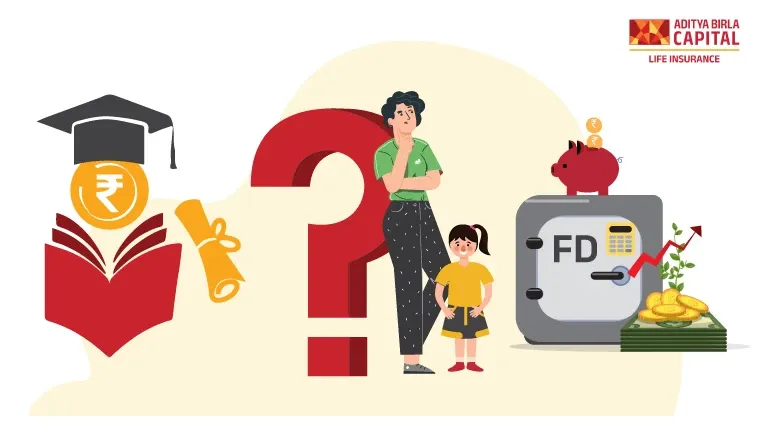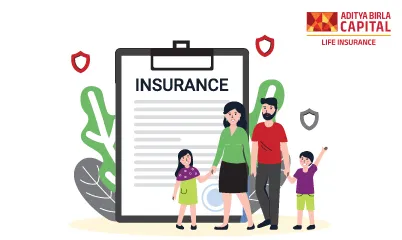With a child comes the responsibility of safeguarding their future. Higher education, marriage, or achieving one of their aspirations could be a plan. As parents, we seek the finest investing, savings, and insurance options. However, whether a kid plan or a child fund is preferable emerges.
What exactly are "child plans"?
A child insurance plan, often known as a "child plan," is a popular insurance option provided by an insurance company. It is an insurance policy and an investment vehicle for your child's future and safety.
What are the advantages of child plans?
Child plans provide the following advantages:
- It gives cash support once you meet the academic milestone.
- It also helps to develop a different corpus for your child's additional financial needs.
- It also has the guaranteed1 benefit of insurance coverage, which will be helpful in the event of your death.
- In the event of an emergency, child plans allow for partial withdrawals of cash.
What exactly are "child funds"?
People use child funds, sometimes known as "child mutual funds," to fund the different critical milestones in a child's life. These funds are typically hybrid or balanced mutual funds that offer investment opportunities for life events such as college and marriage. They are primarily invested in debt and equity and provide long-term capital growth, with the primary goal of providing enough financial support for the child.
In the case of kid mutual funds, people often have a lock-in period that starts around five years. Use Lock-in periods to ensure no funds before the period expires.
What are the advantages of child funds?
Child funds have the following advantages:
- The investment in the child mutual funds occurs over a long time, thanks to the lock-in period.
- It contains a diverse portfolio of assets, which means you can invest in different stages of your child's life, such as schooling, higher education, marriage, and so on.
- A more rigorous investment technique increases return odds when investing in high-risk programs.
- If a child is disabled, their parents may be eligible for additional tax breaks when investing in child funds.
Child plan v/s child fund comparison
Because all of these solutions has benefits and advantages that may favour one. It might take time to determine which is best. Here is a quick tabular comparison for your convenience that will help you comprehend both options better:
|
Child Plan
|
Child Fund
|
| It's a hybrid of investment and insurance. | It offers mutual funds to fund educational or marital aspirations. |
| It includes insurance coverage. | There is no other insurance coverage. |
| It is well-known for being a reliable investment option. | They need a consistent corpus because there are no assured returns. |
| Section 80C applies to it, and the maturity amount is tax-free under Section 10 (10D). 2 option. | Section 80C exempts investments over Rs. 1.5 lakh per year from taxation, although there is a 10% long-term capital gains tax on gains beyond Rs. 1 lakh. |
| There is partial withdrawal in the event of an emergency following the completion of the lock-in period. | There is no option for a partial withdrawal. |
| All investments are due to the degree of risk you are willing to accept to ensure financial stability. | They provide a riskier technique. Returns are proportional to the amount of financial risk you are willing to take. |
| It comes with additional rider perks. | There are no further benefits. |
How can you know which plan will be most helpful?
Using the facts provided above, choose which choice will benefit you when you intend to invest. Before making your final choice, you must consider a few additional factors:
-
Age and investment goal:
The child's age and future needs should be considered when deciding the term to use. Some family plans are intended to be marriage plans, while others are supposed to be educational plans to help pay for high tuition.
Before purchasing children's insurance, the buyer should plan exactly what the child needs.
-
Risk tolerance:
Child insurance plans allow the insurer to increase the policy's waiver benefits for a fee. These premium waiver benefits come in handy if an accident happens while the policy is in effect. According to the waiver, the policyholder won't be responsible for any premium payments.
Always base your decision to purchase child insurance on your ability to pay, your anticipated future needs, and your investment appetite. Risk considerations and inflation factors should also be considered when selecting any insurance policy.
-
The need for returns:
The assured quantity and maturity amount the policyholder selects will significantly affect the premium cost. Make investments based on the amount of money you anticipate needing at the end of the plan's returns. Understanding the different premium payment methods is also helpful and allows you to pay your premium once, twice, or thrice per year.
-
Early investment:
People tend to make the error of delaying their financial preparation until after their child is born. The price of educating a child is increasing dramatically over time. Therefore this may be a mistake.
When the youngster turns 18, he should consider purchasing an insurance plan. As a result, it will be easier to manage the premium payment and benefits over a more extended period.
- Changing requirements:
Your child's requirements will evolve as they develop. You should check if your child's insurance coverage enables customisation to accommodate changing demands. Sometimes, it can be necessary to make partial withdrawals of money, say for educational needs.
To determine whether this is feasible, check with your insurance provider. Look into any provisions for routinely raising the money assured or the tenure by your child's needs.
Conclusion
There are numerous solutions accessible in the market today, whether for a child plan or a child fund. What is more important is to consider how much money you are willing to invest and why. Furthermore, there is no restriction on investing in just one; if you have enough finances and are eager to face additional risks, you may consider investing in both alternatives.
https://scripbox.com/mf/child-plan-vs-child-fund/4










